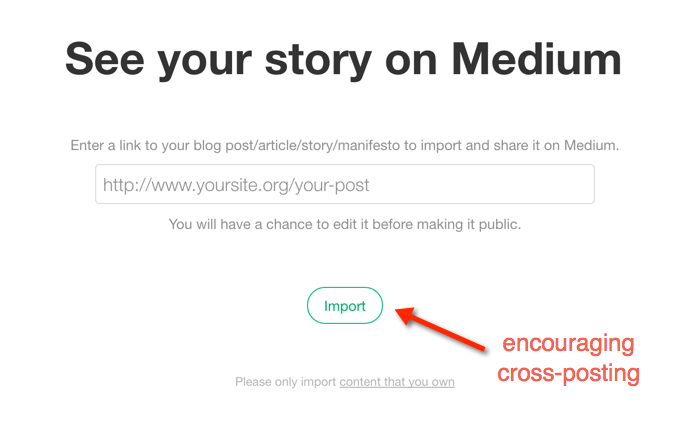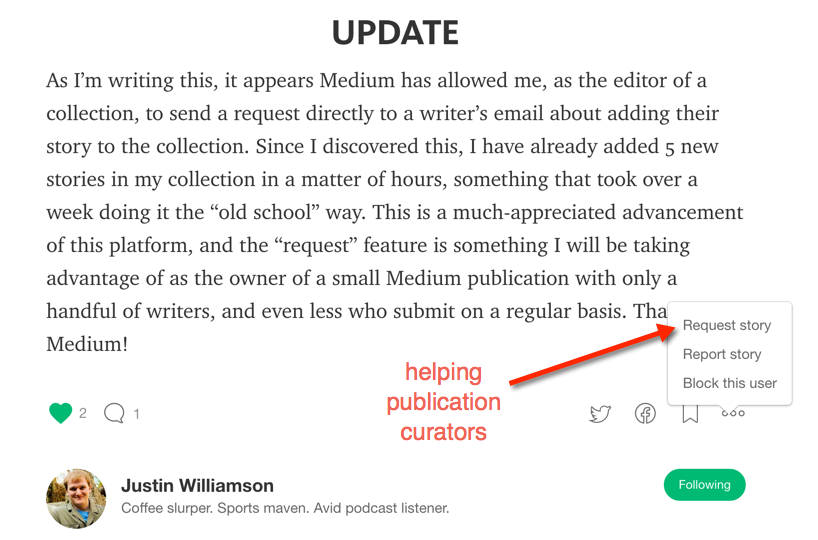First Impression
I first used Medium when I noticed several writers I followed using it. In the beginning, I wrote a story about my journey to the 2014 USA Memory Championship. I also reposted stories I’d written elsewhere, like this one about role models. Later, I experimented with Publications to house related stories.
I’m excited about long-form written content. Some information, debates, and stories simply demand more space for thought, discussion, and reaction. This is the context I had arriving at Medium in April 2014. Over two years later (June 2016), I’m back to take a close look at Medium from a gamification lens.
Before we start: This Gamification Analysis of Medium (Octalysis Level I) will focus on the composition side, meaning the writing of stories and responses and letters. In a future post, I will 1) discuss the reading and consumption side of Medium, and 2) detail my Octalysis Level II journey through Discovery,Onboarding, Scaffolding, and Endgame.
As always: I’ll be referencing the 8 Core Drives of Octalysis throughout:
- Core Drive 1: Epic Meaning & Calling
- Core Drive 2: Development & Accomplishment
- Core Drive 3: Empowerment of Creativity & Feedback
- Core Drive 4: Ownership & Possession
- Core Drive 5: Social Influence & Relatedness
- Core Drive 6: Impatience & Scarcity
- Core Drive 7: Unpredictability & Curiosity
- Core Drive 8: Loss & Avoidance
First Word
My first post on Medium was quick test of the platform that grew into a longer story.
I was initially impressed by the draft and publish options (CD3), the editing features (CD3), and how clean the UI felt. (Later, Medium added the ability to co-write with collaborators or beta readers, a useful method to iterate a story or garner feedback from trusted followers, again CD3.) I actually used Medium to draft this post and was reminded of their effectiveness.
Medium also added a lovely import feature to help a writer’s first story onto Medium:

Notice the capability to edit before going public. This copy gives three advantages:
- Removes CD8 from previous word processor or blog platform
- Encourages first-time users to use their Head Start (CD2)
- Shows off the ease-of-use of editing features (CD3)
The copy on this page is also notable. It doesn’t read: “Add your story to Medium” (which prompts the internal response: Why should I?). Instead, the wording “See your story on Medium” suggests a temporary viewing, an opportunity I’m curious about rather than defensive against. Result? Medium achieves the Desired Action: a writer publishing a story.
For the Import feature, there is little barrier to the Win State. Medium’s approach has led to over 2 million published stories on the platform as of early 2016.
Stories
Stories are any article, post, story, or response to a story. Anytime there is activity on Medium, it revolves around a story. Stories are the engine of Medium.
As a writer, Medium has created an admirable start-to-finish system for ideation, composition, collaboration, editing, publishing, sharing, and discussion. Writers have built communities on Medium who read and react to their stories. Take particular notice of the White Hat motivators in play for writers on Medium.
I’ll cover four aspects here:
- Writing a story is a creative act (CD3)
- Completing a story requires dedication (CD2)
- Sharing a story begins with a desire for influence or relatedness (CD5)
- Connecting with readers renews the next cycle of creativity (CD5 → CD3)
Starting a Story
One click starts a post, story, or response. Medium understands their Desired Action for writers, so they made getting started easy.

Flow (A Useful Ingredient to Completing a Story)
Flow is difficult to describe, but most writers agree they want it. One ingredient in the flow recipe is minimizing distraction. For any composition tool, no-distraction modes are expected.
In the browser, Medium provides a clean writing space with one click. Editing and formatting tools stay out of the way, but can easily be accessed with a highlight or hover. Below I created a private note during the flow of writing:

Sharing with Readers Who I Can Get to Know
As a writer, the opportunity to connect with readers who have recommended your writing is critical (CD5). A recommendation is a public affirmation of one’s story. (I often check if recommenders have written stories and attempt to interact with them through recommendations or responses to their work — more than anything, to me, it’s fun.)

Responses Let Conversations Thrive
Responses build discussion beyond the story. Often, the story is just the beginning.
One of my favorite things to do as a writer is carry on a conversation with a reader who disagrees with something I’ve written (CD5). This is the moment when I get to strengthen my understanding, have a human debate, and grow as a person (also CD2 and CD7).
Medium’s Response infrastructure makes these interactions fun. In some cases, I get more value out of a conversation of Responses than from writing a dedicated story myself. India K (@heartbread) wrote a reflection piece on Orlando. I liked her point of view and wrote a response to it on the spot (“Just read each anecdote twice”), after which she recommended it:

Publications — Owning the Presentation of My Stories
Publications provide a place for readers to find related work. Any user or writer can be the editor of multiple publications.
As a writer, I like having a place to house writing on specific topics (CD4). Publications also serve as a destination for readers to find relatedness, especially if a publication aligns with their personal epic meaning (CD1/CD5).
Publications function in three key ways motivationally:
- As an accomplishment to be included in a Publication (CD2)
- As a creative expression (CD3)
- As a curated experience (CD4, CD5)
Once again, notice how Medium seems to understand when to use White Hat motivators.
I Got Included!
As a writer, it feels great to be included in a Publication (CD2). Because some Publications have large readerships, they function as Leaderboards with their editors determining who gets in and who doesn’t (Elitism).

Creative Expression
Since it’s possible to build a Publication of one’s own writing around a topic, some fiction writers use it to showcase their portfolio.

A Curated Experience
Some Medium users curate stories using Publications to share with their followers. In Medium’s early days, writers submitted stories to the owner of a Collection. Later, Collections became Publications, and owners gained the ability to request a story from writers on Medium. This helped improve the reading experience within Publications and helped writers connect with other writers (CD5).

Letters — Direct Access to Readers
Since mid-2015, Letters have given editors of Publications the ability to send stories by email to their Publication’s followers (these stories are also published in the Publication).

I like that Medium is rewarding dedicated Publication editors with a way to directly communicate with readers. From the editor side, Letters reward CD2 and CD3 (editors who’ve managed to build strong followings) with a feature to create more value for those followings.

Letters call to mind a time when fun and expected news from a close friend or loved one arrived in the mailbox. Here’s Gary Vaynerchuk’s first letter in his Publication–The Entrepreneur’s Journey–only a few days after the Letter feature was added (note, he doesn’t appear to have used them too often afterward.)

Medium Wants To Be Your Medium
As a writer, Medium wants to be the place you write.
I think the team at Medium has continuously shown thoughtful approaches to building the case to be just that.
I haven’t gone all in on Medium, yet, but drafting this post on Medium sure was fun. And hey!, they got me to the Win State. :Just-pressed-publish:
If you’re looking for more about applying motivational psychology, gamified design, and behavioral economics to products or your life, you should consider Yu-kai Chou’s Kickstarter–Octalysis Prime: The Gamified Learning Journey!








